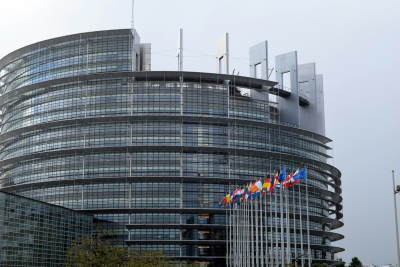Judges have a hard time second-guessing monetary policy decisions. But judicial review remains an important check on the ECB’s far-reaching independence, as the saga over Outright Monetary Transactions Programme, or OMT, highlights.
The ECB is widely recognised as the most independent central bank in the world: it would take treaty change and 28 ratifications, some by national referenda, to amend its mandate. But such a degree of autonomy also limits the scope for democratic control and accountability.
Transparency International EU has consistently shone a light on accountability challenges at the ECB and has previously exposed instances of overreach, such as threatening secret letters to Finance and Prime Ministers in Ireland, Italy and Cyprus. Since the ECB has functional independence, it gets to interpret its own mandate and the tools at its disposal. A case in point was when ECB President, Mario Draghi, announced in June 2012 that the ECB would do “whatever it takes” to save the euro, and to trust him, “it will be enough”. Three months later, the bluff was fleshed out in the Outright Monetary Transactions programme, OMT for short.
The OMT is a programme where the ECB can buy unlimited amounts of bonds issued by Eurozone states, as long as they are bought on the secondary market (i.e. not directly from states) and as long as those states have signed a bailout agreement with the European Stability Mechanism (ESM). But how can the OMT’s bond-buying be considered a tool of monetary, rather than fiscal, policy?
What is the difference between monetary policy and fiscal policy?
Monetary policy is the process by which the supply of money is set, to ensure price stability and/or nominal growth and employment targets.
Fiscal policy is the use of government revenue collection (mainly taxes) and expenditure (spending) and its effects on the economy.
The raison d’être of the ECB is to ensure price stability. But since the crisis it has been largely unable to affect the money supply with its interest rates already set at zero (due to the broken monetary policy transmission mechanism), leading to a consistent failure to meet its inflation target of under but close to two percent. Add in markets speculating against embattled Member States, and it is not difficult to see how the collapse of the Eurozone would make price stability one of its first casualties.
In this reading, purchases of Member State bonds falls into the remit of monetary policy to the extent that it is necessary to safeguard the integrity of the euro. Many however rejected such a “consequentialist” reading of the ECB’s mandate, arguing that the ECB should not further stretch its limits to let Member States off the hook. Within a week of the OMT announcement, a challenge was brought to the German Constitutional Court, setting off an interesting chain of events.
Constitutional turf wars
For the first time in their long and embattled history, the German Federal Constitutional Court, the highest court in Germany, actually submitted a case to the European Court of Justice (ECJ) by referring the OMT challenge in February 2014. This is historic in terms of German and European constitutional law, as it signalled a submission by the national court under the authority of the European court. Although this should have been obvious – the ECJ is the highest court to ensure consistent application of EU law – the ECJ’s supremacy had been partly contested by the German Federal Constitutional Court, which, in its ruling on the 2009 Lisbon Treaty, reserved the right to repatriate cases if it felt the EU had overstepped its powers.
The German submission was a poisoned gift, however: in it, the German court already outlined its opposition to OMT, and emphasised that it reserved the right to overrule the ECJ’s answer, daring the ECJ to disagree. In June 2015, the ECJ did just that. Since then, we have been waiting to see whether and how the German Federal Constitutional Court would swallow its pride, and concede defeat.
Today it did, setting only some limits on the way the German Central Bank may participate in the ECB’s OMT, if ever it is used. These restrictions are of a very theoretical nature, given that OMT is intended as a deterrent, never to be activated for knowledge it is there. Nonetheless, we narrowly avoided outsourcing the constitutional crisis between the top courts to the European System of Central Banks.
ECJ review of OMT-legality
It should be obvious that not all 19 Eurozone constitutional courts can second-guess the ECB’s actions. But how did the ECJ fare in assessing the legality of OMT? The effectiveness of the ECB’s legal accountability hinges on the merits of the ECJ’s assessment.
As Transparency International EU has done before, the ECJ criticised the ECB’s difficult role as part of the Troika (ECB, European Commission, International Monetary Fund) in the implementation of EU bailouts: the ECB is responsible for a country’s monetary policy, and the interactions between monetary and other economic policy fields, but it simultaneously judges a country’s fulfilment of conditionality attached to any bailout, alongside the IMF and the European Commission, effectively sitting on both sides of the table.
Here the ECJ has gone further than the German Constitutional Court by uncovering new challenges to OMT. As it is pitched by the ECB as a monetary policy tool designed to restore the functioning of the monetary policy transmission mechanism, making the implementation of OMT contingent on the fulfilment of programme conditionality by a bailout-country would undermine the ECB’s independence. Only monetary policy considerations should therefore drive OMT.
EU politicians are unwilling or unable to use fiscal policies and structural reforms to boost the economy, or to create a sustainable institutional architecture for Economic and Monetary Union. This means that a lot more burden is falling on the ECB’s shoulders than should be the case, and certainly more than was thinkable at the time when its statutes were written. The ECB’s actions in these unchartered and unconventional waters pose new challenges in terms of holding it to account.
This will remain a challenge. Transparency International EU is currently working on a study to spell out in detail how transparent the ECB’s decision-making is towards the media and public, how it ensures the integrity of its staff and to whom it is accountable.
Learn more about this project here, and consider joining our advocacy efforts for a more transparent and democratic Eurozone.






